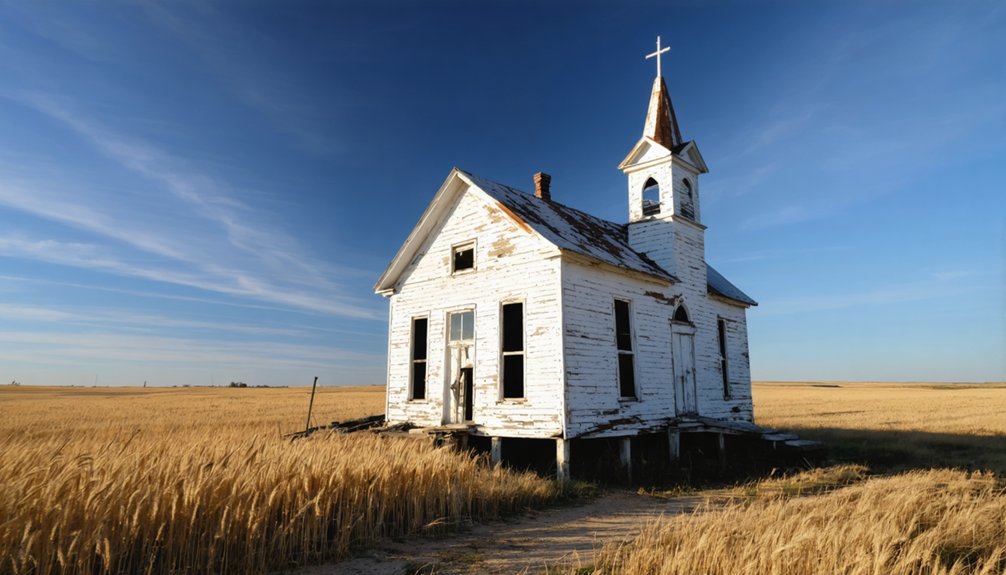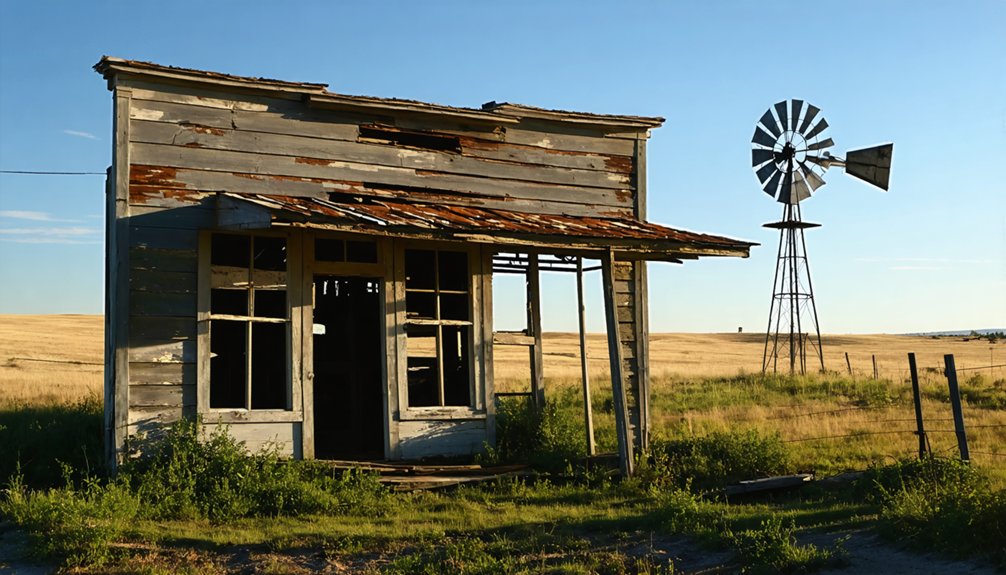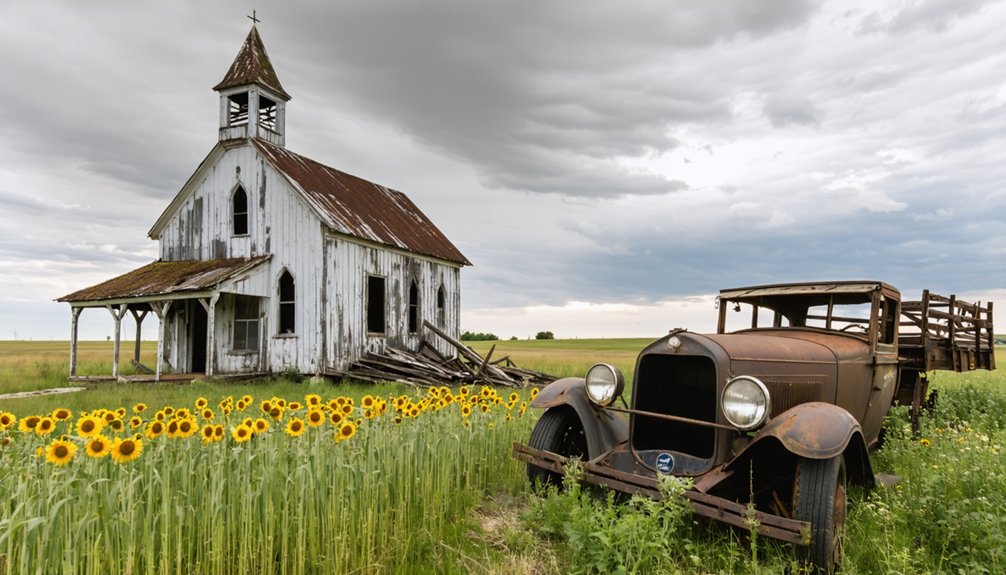You’ll find Boughton’s abandoned ruins scattered across South Dakota’s prairie landscape, where a bustling railroad town once thrived in the late 1800s. The Chicago, St. Paul, and Milwaukee Railroad brought life to this settlement during the Great Dakota Boom of 1878-1887, creating a vibrant community with grain elevators and busy depots. By the 1950s, economic decline left only weathered foundations and partial walls, though local folklore and supernatural tales keep Boughton’s spirit mysteriously alive.
Key Takeaways
- Boughton was established during South Dakota’s late 19th century westward expansion and thrived briefly due to railroad connections.
- The town’s layout was T-shaped, centered around the Chicago, St. Paul, and Milwaukee Railroad depot and grain elevators.
- Economic decline began when industries closed, causing workers to leave and businesses to shut down by the 1950s.
- Today, only weathered building foundations, partial walls, and remnants of grain elevators remain amid prairie vegetation.
- Local folklore includes supernatural tales about the abandoned grain elevator and chapel, plus a nearby 1919 influenza pandemic grave.
Historical Origins and Settlement
Boughton emerged in South Dakota during the late 19th century as part of America’s westward expansion, drawing homesteaders seeking agricultural opportunities on the plains.
You’ll find that settler experiences centered around establishing mixed-use farms, where families adapted to harsh prairie conditions while building a tight-knit community.
The town’s founding reflected the era’s agricultural practices, with settlers staking claims under the Homestead Act and developing modest farmsteads.
Like many towns that would become ghost towns, Boughton’s early settlers faced uncertain economic conditions that would ultimately impact its longevity.
They built essential structures including homes, barns, and community buildings while managing relationships with native tribes who’d historically inhabited the region.
Local families relied on access to water sources and fertile soil, developing their properties to accommodate both crop cultivation and cattle ranching.
The town’s placement near transportation routes helped sustain early growth and trade connections.
Similar to the historic Gaslight Restaurant in Rockerville, early businesses played a crucial role in maintaining the town’s economic vitality.
Economic Rise and Railroad Influence
When the Chicago, St. Paul, and Milwaukee Railroad expanded its operations through South Dakota, you’d witness a dramatic economic transformation in towns like Boughton. The railroad’s strategic placement of routes and depots shaped the town’s development, following a typical T-shaped layout with commercial activity centered around the rail station.
Railroad executives and investors, including A.M. Bowdle and J.D. Lawler, capitalized on this expansion by acquiring prime land near the tracks. Many business owners eagerly sought railroad’s market potential, just as J.D. Welch had anticipated for his cattle company. The explosive growth mirrored the success seen when the first steam locomotive arrived in Chicago in 1848, sparking rapid development across the Midwest.
Savvy railroad magnates and speculators swooped in to secure valuable real estate adjacent to newly laid tracks.
You’ll find that Boughton’s rise paralleled the Great Dakota Boom of 1878-1887, as rail access provided essential connections for mail, goods, and passenger transport. The town’s grain elevators and warehouses became significant export points, cementing Boughton’s role in the regional agricultural economy.
The railroad’s influence remained paramount until automobiles began dominating transportation after World War II.
Daily Life and Community Infrastructure
Despite its relatively small size, daily life in this prairie railroad town revolved around a close-knit community of railroad workers and their families.
You’d find residents gathering at the general store, sharing news and supplies, while children attended the local one-room schoolhouse if one existed. Community activities centered on survival and mutual support, with families helping each other through harsh prairie conditions. Like many towns that experienced decline after World War II, the social fabric began to unravel as families moved away.
The town’s basic infrastructure included essential services like wells and outhouses, with no advanced plumbing systems in place. Similar to nearby Okaton, the town relied heavily on its grain elevator for agricultural commerce.
Social interactions often occurred around the railroad depot, where residents could collect mail and supplies. You’d see evidence of self-sufficiency in backyard gardens and small livestock operations, as families worked to supplement their railroad-based income with home-grown food.
The Path to Abandonment
Like many South Dakota ghost towns, you’ll find Boughton’s story of decline rooted in the closure of primary industries and the subsequent loss of employment opportunities that forced residents to seek work elsewhere.
The exodus of workers and their families accelerated as local businesses shuttered, creating a downward economic spiral that made the town increasingly unsustainable. Similar to the effects of the Dirty Thirties, severe economic conditions drove many residents away, leaving abandoned buildings and empty streets behind.
You can trace the town’s final descent through the typical pattern of South Dakota ghost towns, where younger generations left for urban opportunities, leaving an aging population that gradually diminished until the community could no longer support itself.
Economic Forces Drive Decline
Throughout the mid-20th century, a perfect storm of economic forces drove Boughton’s transformation from a thriving agricultural community into a ghost town.
You’ll find the roots of this economic transformation in the devastating combination of the Great Depression and Dust Bowl, which first weakened the town’s agricultural foundation. Modern technology enabled fewer farmers to manage larger plots of land. As farming mechanized and consolidated, rural depopulation accelerated, with fewer farmers needing fewer services. Like neighboring town Fulton’s 51 residents, Boughton’s population steadily declined through the 1960s.
You can trace Boughton’s decline through the closure of local businesses, unable to survive as their customer base dwindled.
When new highways bypassed the town and railroad service diminished, isolation deepened. Young residents left for urban opportunities, while aging populations remained.
Without sufficient economic activity to sustain basic services, Boughton’s remaining families faced impossible choices, ultimately leading to abandonment.
Population Exodus Timeline
When Boughton first emerged in the late 1800s, its population trajectory followed a pattern typical of Black Hills mining settlements – rapid growth followed by gradual decline.
You’ll find the town’s demographic shifts unfolded in distinct phases, beginning with the early 1900s exodus as mining impacts diminished and railroad operations slowed. The harsh weather conditions and agricultural challenges mirrored the struggles faced by other South Dakota settlers trying to build new lives.
The Great Depression dealt another blow in the 1930s, driving more residents away as businesses shuttered and community services vanished.
World War II and postwar industrialization accelerated the town’s emptying, drawing younger residents to larger urban centers.
By the 1950s, you’d have found Boughton nearly deserted, with just a handful of determined families remaining.
The final phase of abandonment played out through the 1960s and early 1970s, leaving behind only empty buildings and memories.
Remnants and Present-Day Conditions

While most South Dakota ghost towns fade into obscurity, Boughton’s remnants paint a stark portrait of rural abandonment.
You’ll find weathered building foundations and partial walls scattered across the prairie landscape, where structural decay meets natural reclamation. The site’s wooden structures have largely collapsed after decades of harsh winters and abandonment.
Today, you’ll encounter an area largely devoid of commercial development, with unpaved access roads and abundant prairie vegetation reclaiming the land.
Rustic foundations and possible remnants of grain elevators stand as silent witnesses to the town’s agricultural past.
If you’re planning to explore, remember that private property restrictions may limit access. The surrounding plains offer dramatic backdrops for photography, while any remaining structures provide glimpses into the region’s transient settlement patterns.
Local Stories and Legends
Beyond the physical remnants of Boughton’s weathered structures lies a rich tapestry of local folklore and supernatural tales.
Beneath Boughton’s crumbling walls and faded facades, generations of ghostly stories whisper through time.
You’ll discover haunted folklore stretching from the abandoned grain elevator to the old chapel, where locals report ghostly apparitions and unexplained phenomena. The railroad’s history, particularly its 1906 construction and eventual closure, intertwines with stories of hardship and loss.
- Shadow figures dart between the deteriorating sawmill buildings, accompanied by mysterious sounds that echo through the night.
- The nearby grave of a mother and two children from the 1919 influenza pandemic serves as a somber reminder of tragedy.
- Photographers and visitors regularly experience an otherworldly atmosphere, especially around the former railroad areas.
These supernatural elements have become deeply woven into Boughton’s identity as a South Dakota ghost town.
Legacy in South Dakota’s Development

Through its rise and fall, Boughton exemplifies the broader patterns of development that shaped South Dakota’s early settlement history.
You’ll find its legacy woven into the state’s cultural memory, particularly in how it reflects the economic shifts that transformed rural communities during the frontier era.
Like many ghost towns, Boughton’s historical significance extends beyond its physical remains.
It serves as a representation of the dynamic forces that influenced settlement patterns – from railroad development to agricultural mechanization.
The town’s story helps you understand how transportation networks and resource exploitation shaped South Dakota’s growth.
Today, Boughton’s documented existence continues to inform researchers and historians about rural community evolution, while contributing to the state’s collective understanding of its pioneering past.
Frequently Asked Questions
Are There Any Paranormal Activities or Ghost Sightings Reported in Boughton?
Like a blank canvas waiting for its first brushstroke, you won’t find documented ghost stories or haunted sites in Boughton. Current research shows no verified paranormal activity or ghost sightings in this abandoned town.
What Happened to the Original Town Records and Documents?
You won’t find most of Boughton’s original town archives today – they weren’t systematically preserved. Without formal historical preservation efforts, records were lost to neglect, deterioration, or discarding during the town’s decline.
Can Visitors Legally Collect Artifacts From the Boughton Site?
You can’t legally collect artifacts without explicit permission. There aren’t any visitor regulations specifically allowing collection, and South Dakota law typically requires permits for removing historically significant items.
Were There Any Notable Crimes or Murders in Boughton’s History?
While there aren’t documented murders or crimes, you’ll find that historical records of Boughton’s unsolved mysteries and local legends remain incomplete, unlike nearby Owanka which had notable bank robberies.
Did Any Famous Historical Figures Ever Visit or Stay in Boughton?
You won’t find any A-list historical celebrities in Boughton’s guestbook – there’s no documented evidence of famous visitors ever gracing this small mining town with their presence or historical significance.
References
- https://www.sdpb.org/rural-life-and-history/2023-08-21/some-black-hills-ghost-towns-and-their-origins
- https://www.powderhouselodge.com/black-hills-attractions/fun-attractions/ghost-towns-of-western-south-dakota/
- https://www.youtube.com/watch?v=_0WNYsFLSLA
- https://icatchshadows.com/okaton-and-cottonwood-a-photographic-visit-to-two-south-dakota-ghost-towns/
- https://aberdeenmag.com/2019/01/the-ghost-towns-of-brown-county/
- https://en.wikipedia.org/wiki/List_of_ghost_towns_in_South_Dakota
- https://www.legendsofamerica.com/south-dakota-ghost-towns/
- https://www.legendsofamerica.com/gt-emergingghosttowns/
- https://www.atlasobscura.com/things-to-do/south-dakota/ghost-towns
- https://www.legendsofamerica.com/sd-okaton/



